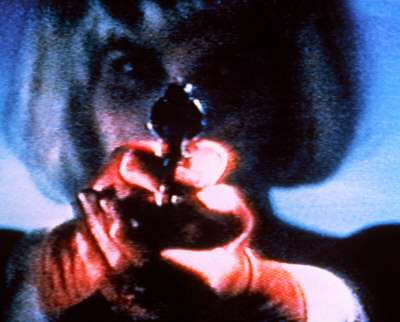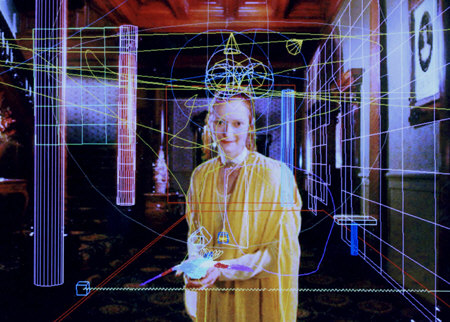Per Contra Winter 2006-2007
Lynn Hershman Leeson, The Per Contra Interview by Miriam N. Kotzin

DiNa with microphone one way mirror

Room

Ada with Bird
MK: You’ve said, “In retrospect, I believe Roberta and I were linked. Roberta represented part of me as surely as we all have within us an underside—a dark, shadowy cadaver that is the gnawing decay of our bodies, the sustaining growth of death that we try with pathetic illusion to camouflage. To me she was my own flipped effigy: my physical reverse. She exposed my fears.” [“Private I: An Investigator’s Timeline.” The Art and Films of Lynn Hershman Leeson: Secret Agents, Private I, p. 33] Was that only in retrospect?
LHL: Yes, I really thought she was separate to begin with, but we never can separate ourselves truly, some kind of imprint remains, even in digital culture.
MK: You’ve mentioned in “Private I” that among the influences on your creation of Roberta were Breton’s Nadja, Jerzy Krotowski’s theater, Thadeusz Kantor and Joseph Beuys. Roberta wasn’t going to be little Miss Sunshine.
LHL: No way!
MK: You went to some trouble to establish a separate identity for Roberta; did you expect that the project would be as sustained and complex as it became?
LHL: Absolutely not. Had I known I don’t think I would have done it, but she needed the time to flesh herself out in the real world, and that took a good part of a decade.
MK: How did your relationship with that performance change over time?
LHL: It was more Zen-like as I watched things happen to her and understood more deeply the alienation that single women in our culture suffer from.
MK: Your working for Christo and Jeanne-Claude overlapped Roberta Breitmore in time. How much of what you did for them was on the road? What did that mean for Roberta?
LHL: I was in Petaluma a lot, but that was an hour away so Roberta’s life continued as usual.
MK: “Dante Hotel” departs from the history of installation and performance as begun by Allan Kaprow?
LHL: No, I don’t think so. What did he do? It was bringing the idea of the “ready made” into a trajectory of art that used “lived experience” as its content.
MK: I’d like to ask about some of the awards you’ve received. The Flintridge Foundation honored you in l998 for the work you’ve done over your career. Was the l999 Golden Nica Prize at Ars Electronica in Linz, Austria for work from that festival?
LHL: No, it was for the Difference Engine # 3, a commission for the ZKM Media Museum that was horribly difficult and took nearly three years surviving many near deaths and many failures.
MK: Difference Engine, the title of that work referred to the Babbage Difference Engine, I suppose? And the thirty-one figures in Difference Engine #3 relates to the thirty-one figures of his engine?
LHL: Exactly, what a thorough and well-researched interview! Most people never get that.
MK: About a decade ago you edited Romancing the Anti-Body, Lust and Longing in Cyberspace, in Clicking In, Hot Links to a Digital Culture. Would you tell us a about that project? (Bay Press: Seattle) 1996.
LHL: Well, I was talking to lots of really bright folks for various videotapes I was doing, and I thought I would just collect the thoughts and interviews in this one accessible book. People still find it useful.
MK: You’ve done a number of videos and two feature-length pieces. Would you talk a bit about how you came to do Conceiving Ada, and how you used technology to do the sets?
LHL: Some things take over your life. When I heard about Ada, I remembered thinking, why didn’t I know about her earlier? She changed our life yet was in l993, relatively invisible. So I felt I had to let others know about her accomplishments, and, also, her life was so dramatic. I used digital technology because I had no money to build sets so I invented Virtual Sets out of desperation for a solution. Tilda Swinton agreed to be in it. I hadn’t met her and didn’t want to be embarrassed. Also, it was a more relevant way of talking about Ada, about the past, future, and present. Miraculously, it worked out.
MK: Your comments quoted above that summarized your themes as “identity, of surveillance, the pervasiveness of media” were in an interview about Teknolust. Do you still want to do a film on Frankenstein, or have you moved away from that?
LHL: Yes, I would love to do it, but what I had in mind cost a little more than lunch money, which is how I made everything else so far.
MK: In an interview on Ziggy’s Video Realm you mentioned that among your influences were Akira Kurosawa, Billy Wilder, Yves Klein, Cezanne, Emma Goldman and Tina Modotti. And in Cavalier Daily you named Altman, Scorsese, Kurosawa, Lang and Man Ray. That’s a pretty diverse group. I can think of a number of reasons that each of these might be influences, but to pull out three, if you don’t mind: Kurosawa? Cezanne? Man Ray?
LHL: Kurosawa’s use of the double, his beautiful drawings and storyboards, his depth of understanding of human emotion; Cezanne for his truly groundbreaking courage in devising his own language, a language built out of erasure, and Man Ray because of his invention, persistence, determination, curiosity, and ultimately, again, courage.
MK: I saw that your work is going to be available on mobile phones. What? What do you think of that new method of getting work seen? How will its constraints create new forms?
LHL: No constraints at all, as I see it, just more access.
MK: What about the limitations on length of the art work, on the size of the screen, the double possibility of speaker phone and positioning the cell phone to the ear (which allows for much more intimacy, especially if the image speaks to the viewer and asks for that or vice versa?
LHL: Sometimes limitations can be an advantage. There is a lot of freedom in limitation, and it is just a matter of exploiting potential.
MK: What are your networks?
Agent Ruby can be found on the web [www.agentruby.com/indexflash.html] and can be downloaded onto a palm pilot. As “she” changes and learns on the web, what will happen on the palm pilots? In an environment with one other person (the owner of that palm), will that Agent Ruby evolve into a different being than an Agent Ruby on another palm pilot or the one on the web?
LHL: Agent Ruby morphed into DiNA who has instant access to everything on the net and talks via speech recognition in real time animation. Dina is Ruby’s grand daughter. The palm version was the daughter. The generations get better, as with humans.
MK: What’s coming next?
LHL: A feature film on the history of feminist art in America; part three of the trilogy with Conceiving Ada and Tecknolust, an “emotional barometer” that measures [the] continent’s pollution levels, a series on sex dolls, you know the usual…
MK: And again, many thanks.